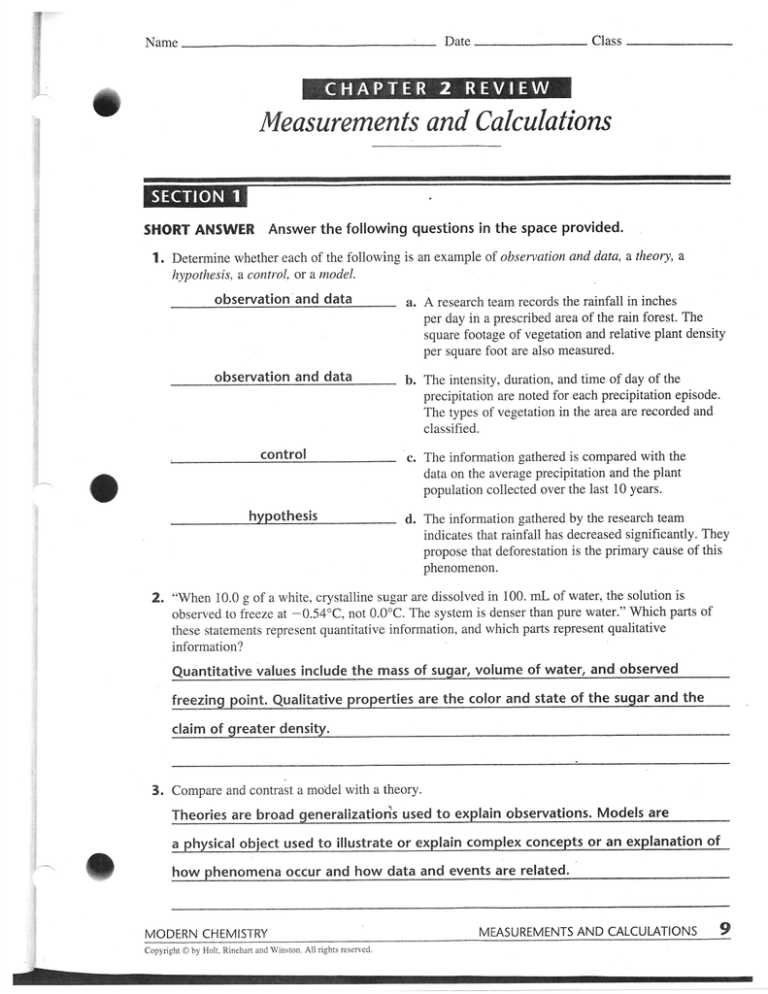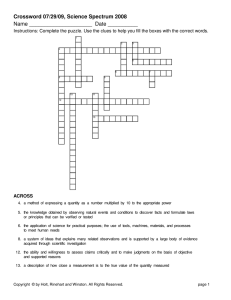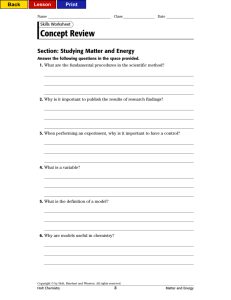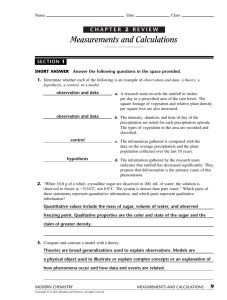
il
*
,;l,
Class
Date
Name
1{
.1:
,!*
']t
t:
a
Measurements and Calculations
@
SHORT ANSWER Answer the following questions in the space provided.
1.
Determine whether each of the following is an example of observation and data, a theory,
hypothesis, a control, or a model.
a
observation and data
a. A research team records the rainfall
observation and data
b. The intensity, duration, and time of day of the
precipitation are noted for each precipitation episode.
The types ofvegetation in the areaare recorded and
classified.
in inches
per day in a prescribed area of the rain forest. The
square footage of vegetation and relative plant density
per square foot are also measured.
control
The information gathered is compared with the
data on the average precipitation and the plant
population collected over the last 10 years.
hypothesis
d.
The information gathered by the research team
indicates that rainfall has decreased significantly. They
propose that deforestation is the primary cause of this
phenomenon.
2.
"When 10.0 g of a white, crystalline sugar are dissolved in 100. mL of water, the solution is
observed Io freeze at -0.54oC, not 0.0'C. The system is denser than pure water." Which parts of
these statements represent quantitative information, and which parts represent qualitative
information?
Quantitative values include the mass of sugar, volume of water, and observed
freezinq point. Qualitative properties are the color and state of the sugar and the
claim of qreater density.
3. Compare and contrast a model with a theory.
Theories are broad
ralization*s used to
lain observations. Models are
a ohvsical obiect used to illustrate or explain complex concepts or an explanation of
how ohenomena occur and how data and events are related.
i
:
I
!
MODERN CHEMISTRY
Copyright O by Holt, Rinehart and Winston. All rights reserved
MEASUREMENTS AND CALCULATIONS
9
Date
Name
SECTION
4.
I
Class
continued
Evaluate the models shown below. Describe how the models resemble the objects they represent
and how they differ from the objects they represent.
The model of the sun accurately shows that the sun is round and has a fiery surface,
but the model is much smaller than the real sun and does not show the sun's
composition. The model of an atom accurately shows that an atom is a particle, but
the model is much larqer than a real atom and does not depict an atom's
compo5ition or shape.
5.
c
How many different variables are represented in the two graphs shown below?
a.
one b. two
c.
three d. four
Fs4
f 52"
H 5oo
ts 48o
46
,6
F
Aug. Sept. Oct. Nov. Dec, Jan, Feb. Mar. Apr. May June July
(a
6)
I
10
8
6
4
2
Jan. Feb. Mar. Apr. May June July Aug, Sept. Oct. Nov. Dec.
'10
MEASUREMENTS AND CALCULATIONS
MODERN CHEMISTRY
Copl'right O by Holt. Rinehart and Winston. All rights resen'ed.
Name
Date
Class
Measurements and Calculations
@M
SHORT ANSWER Answer the following questions in the space provided.
1.
Complete the following conversions:
a.
100
mL
b.
0.25
g:
c.
400 cm3
:
d. 400 cm3
0.1
25
cg
0.4
L
0.0004
m-
2. For each measuring device
remain constant and when
1
shown below, identify the quantity measured and tell when
it would
it would vary.
Device a measures weiqht (the effect of the gravitational force on rhass), which
chanqes with location on Earth and when measured on a different planet or moon.
Device b measures mass,which does not change with location because gravity affects
both the measured body and the mass standard equally. Device c measures volume
o
of a liquid, which changes slightly with temperature and pressure. Weight, mass, and
volume do not change with the shape of the obiect.
MODERN CHEMISTRY
Copyright O by Holt, Rinehan and Winston. Al1 rights reserved.
M EASUREMENTS
AND CALCU LATIONS
11
Date
Name
SECTION
Class
2 continued
3. Use the data found in Table 4 on page 38 of the text to answer the following
sink
0
questions:
If ice were denser than liquid water at OoC, would
it float or sink in water?
x,q(ft
a ,,cL
b. Watei and keiosene do not dissolve readily in one
another. If the two are mixed, they quickly separate
into layers. Which liquid floats on top?
kerosene
mercury
H0q.f;, i" r"D;Pq1 that do ,\3q kirror". i"
"th*
water are gasoline, turpentine, and mercury. Which of
c. rhe
these liquids would settle to the bottom when mixed
with water?
4.
Use the graph of the density of aluminum below to determine the approximate mass of aluminum
samples with the following volumes.
g
4g
20 g
9g
22
a.
Mdss vs. Volume of Aluminum
8.0 mL
b. r.5o mL
mL
d. 3.50 mL
25'o
c. 7.25
2o.o
6
0
;1b.0
q
a
10.0
5,0
Volume (mL)
PROBLEMS Write the answer on the line to the left. Show all your work in the space
provided.
5.
27.0 q
Aluminum has a density of 2.70 glcm3. What would be the mass of
sample whose volume is 10.0 cm3?
V=n1
6.
14 cm
N,\
= PV
-'
(z 1D &4(
a
tc o ,,#)
A certain piece of copper wire is determined to have a mass of 2.00 g
per meter. How many centimeters of the wire would be needed to
provide 0.28 g of copper?
7'c05
= \nr
D
7?,
I
ol
I'^ | l00ar
J-J
z,r,ot I I ,n
i
I
12
M EASUREM ENTS
AND CALCULATIONS
MODERN CHEMISTRY
Copyright O by Holt, Rinehart and Winston.
All
rights resened.
Class
Date
Name
Measurements and Calculations
@
SHORT ANSWER Answer the following questions in the space provided.
1.
2.
Report the number of significant figures in each of the following values:
3
4
a.
o.oo2 37
g
b. o.oo2 037 g
2 6. 64 mL
2 e. 1.3 X 102 cm
3
c.
350.
3
J
1.30
x
102 cm
Write the value of the following operations using scientific notation'
103
1o-1
3.
f.
x
io-6
a' ---10-t-
4 x'lo-2
9x103
-o'tt-ib'
4.3 x'lO4
c.3X103+4.0x104
The following data are given for two variables, A and B:
AB
18
12
a. In the graph provided, plot the data.
61218
B
inversely proportional
No
AXB:k
b. Are A and B directly or inversely proportional?
c. Do the data points
d. Which equation fits the relationship shown by the data?
4: t(a
36
MODERN CHEMISTRY
Copyright O by Holt, Rinehan and Winston. All rights reseryed.
form a straight line?
constant)
orA X B
B
What is the value of
:
k?
MEASUREMENTS AND
k(a constant)
<d / ' /I
'/
CALCULAT'ONS
'-'
13
Name
Date
Class
SECTION 3 continued
Carry out the following calculations. Express each answer to the correct number of
figures and use the proper units.
40.0
m
2000 mL or 2
L
t5tmL
100m1
5.
a.
37.26
m -t 2.7 m
b,
256.3
mL
".W
significan, 0
* 0.0015 m :
* 2L + 137 mL:
547
tPa
346mL x 200K
a.Y#
546.4K
Round the following measurements to three significant figures.
g
'14.6 m
b.
9.31
c. 9.3052L
22.8
L
87.6 cm
30.2 s
a. 2237
d.
g
t4.62m
87.55 cm
e. 30.25 g
^rlOBtEMS Write the answer on the line to the left. Show
alt your work in the
space
,-,'ovided.
6.
I
A pure solid at a fixed temperature has a constant density. We know that
mass
densiy
or D :4'
- - volume
v
directly
proportional
a. Are mass
and volume directly proportional or
proportional
inversely
for a fixed density?
6.0 cm3
b. If a solid has a density of 4.0 g/cm3, what volume
of the solid has a mass of 24 g?
P-
n1 V,F .- m
V
V = rYl
,.
24,1_.-
V
4
,41 ""t'='
7. A crime-scene tape has a width of 13.8 cm. A long strip of it is torn off and measured to be
56 m long.
5600
7
cm
'7 x "loa cm2
a.
Convert 56 m'into centimeters.
b.
What is the area of this rectangular strip
ll
14
oo.
of
tape,
in
cmz?
trvl v 4bA0 c,tt
MEAsUREMENTS AND cAlcur-ATroNs
t
MODERN CHEMISTRY
Copyright
@
by Holt, Rinehart and Winston. All rights reserued.
Name
Date
Class
Measurements and Calculations
@
SHORT ANSWER Answer the following questions in the space provided.
1.
Match the description on the right to the most appropriate quantity on the left.
d
zmt
(a)
mass of a small paper clip
?
ns
"'" b
(b)
length of a small paper clip
0.5 kg
(c)
length of a stretch limousine
6oo cm2
(d)
volume of a refrigerator compartment
2omm
(e)
surface area of the cover of this workbook
(f)
mass of a jar of peanut butter
f
e
b
2.
a
A measured quantity is said to have good accuracy
if
(a) it agrees closely with the accepted value.
(b) repeated measurements agree closely.
(c) it has a small number of significant figures.
(d) all digits in the value are significant.
3. A certain sample with a mass of 4.00 g is found to have a volume of 7.0 mL. To calculate the
density of the sample, a student entered 4.00
the answer as0.571429.
Yes
+ 7.0 on a calculator. The calculator display shows
a. Is the setup for calculating
b. How many significant
4.
density correct?
figures should the answer contain?
It was shown in the text that in a value such as 4000 g, the precision of the number is uncertain.
The zeros may or may not be significant.
4.00
x
103 q
a.
Suppose that the mass was determined to be 4000 g. How many
significant figures are present in this measurement?
b.
Suppose you are told that the mass lies somewhere between
3950 and 4050 g. Use scientific notation to report the value,
showing an appropriate number of significant figures.
.
5. If you divide a sample's
mass by its density, what are the resulting units?
Volume units: for exampl",
ffi
MODERN CHEMISTRY
Copyright O by Holt, Rinehan and Winston. All rights reserved.
:
mL
M EASUREMENTS
AND CALCU LATIONS
t5
Class
MIXED REVIEW continued
6.
Three students were asked to determine the volume of a liquid by a method of their choosing. Each
performed three trials. The table below shows the results. The actual volume of the liquid is 24.8 mL.
Trial
Trial
1
2
Trial 3
(mL)
(mL)
(mL)
Student A
24.8
24.8
24.4
Student
B
24.2
24.3
24.3
Student
C
24.6
Student
C
25.0
a. Considering the average of all three trials,
which student's
measurements show the greatest accuracy?
Student
B
b. Which student's
measurements show the greatest precision?
PROBTEMS Write the answer on the line to the left. Show all your work in the space
provided.
7.
2.0
x "lo'g
i n1r,rrr = 7 .LE , I0-" q
A single atom of platinum has a mass of 3.25
mass of 6.0
x
1023
tD'+ alo*t
!:,
8.
q/mL
70-22 g. What is the
79 n ro-'1i
\4
i
\ r\t,rn
A sample thought to be pure lead occupies a volume of 15.0 mL and has
'10.7
x
platinum atoms?
a mass
of
= V,
I
160.0 g.
a. Determine its density.
Q'-
4
=
V
No
Is the sample pure lead? (Refer to Table 4 on page 38 of the text.)
6.0o/o
Determine the percentage error, based on the accepted value for the
t\,4E
density of lead.
h
o 1 - \\.2:9
t\ .?29
o)
)
lbO
ico
=1
erYb{'
-6tv
l,
t
16
MEAsUREMENTs AND
cAlcuLATIoNs
MODERN CHEMISTRY
Copyright O by Holt, Rinehart and Winston. All rights resened.
9f orn'







